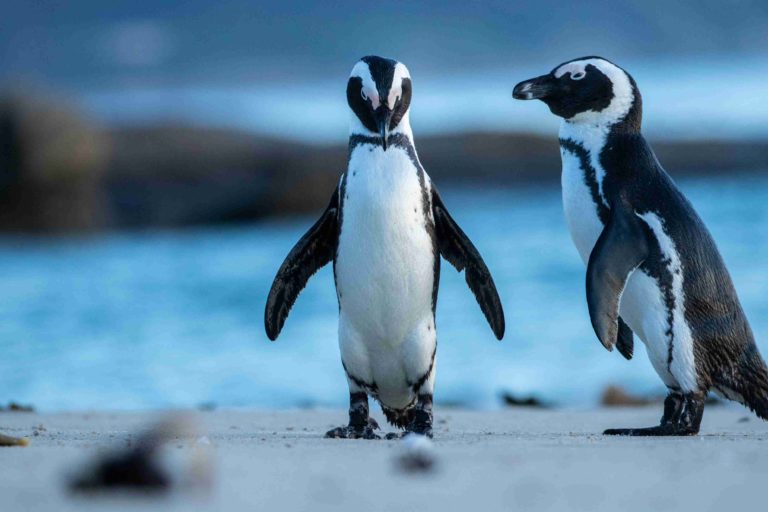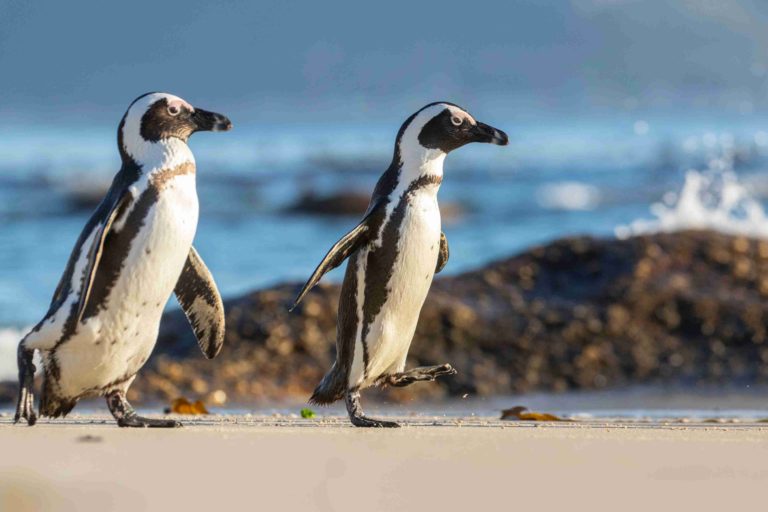[ad_1]
A new study on the paleo-historical geographic range of the endangered African penguin since the last Ice Age paints a grave picture of a species in steep decline.

Imagine the view from the western coastline of southern Africa during the Last Glacial Maximum (LGM) over twenty thousand years ago: in the distance, you would see at least fifteen large islands – the largest 300 square kilometres in area – swarming with hundreds of millions of marine birds and penguin colonies.
Now imagine sea levels rising up to a hundred metres between fifteen to seven thousand years ago, gradually covering these large islands until only small hilltops and outcrops remained above water. Over the past 22 000 years this resulted in a tenfold reduction in suitable nesting habitats for African penguins, sending their population numbers into steep decline.
This is the paleo-historical picture of the geographical range of African penguins, created by scientists in the evolutionary genomics research group in the Department of Botany and Zoology and the School for Climate Studies at Stellenbosch University (SU). With this effort, they hope to provide new insight into the current vulnerability of the last remaining penguin species in Africa.
The study, titled “A natural terminal Pleistocene decline of African penguin populations enhances their anthropogenic extinction risk” was published in the African Journal of Marine Science on 20 April 2023.
Dr Heath Beckett, first author of the article and postdoctoral fellow at SU’s School for Climate Studies, says this paleo-historical image of multiple millions stands in stark contrast to the current reality of a post-1900 collapse of the African penguin population.
In 1910, Dassen Island (an island off the West Coast, about three square kilometres in area) was teeming with an estimated 1.45 million penguins. However, by 2011 South Africa’s entire African penguin population collapsed to 21 000 breeding pairs, and by 2019 they further declined to only 13 600. Approximately 97% of the current population in South Africa is supported by only seven breeding colonies.
In May 2005 the International Union for the Conservation of Nature classified the African penguin as endangered.
Paleo-historical estimates of penguin population sizes
So how did the southern and western coastlines of southern Africa look like during the last Ice Age? And what can it tell us about penguin population numbers?
As penguins prefer to breed on islands to escape mainland predators, the researchers used topographic maps of the ocean floor off the coast of southern Africa to identify potential historical islands lying at ten to 130 metres below current sea levels.
For islands to qualify as suitable for penguins they needed to offer protection from land-based predators and had to be surrounded by suitable foraging grounds for sardines and anchovy within a 20-kilometre radius.
Assuming that sea levels were much lower during the last Ice Age, they identified 15 large islands off the West Coast, the largest a 300 km2 island lying 130 metres below the sea surface. Then taking into account rising sea levels over the past 15 000 to 7 000 years, they identified 220 islands which would have provided suitable nesting conditions for penguins, of which 216 are less than one km2 in area, while some are as small as 30 m2, barely more than a rock.
Today the five largest islands off the West Coast of Southern Africa are Robben Island (~5 km2), Dassen Island (~3 km2), Possession Island (~ 1.8 km2) and Seal Island and Penguin Island (both below 1 km2). Possession, Seal and Penguin Island are all off the coast of Namibia.
Based on the earliest available population density estimates, they then calculated penguin population estimates based on the available island area, assuming that penguins usually nest 500 metres from the shore.
Following this approach, they estimate that between 6.4 million and 18.8 million individuals could have occupied the southern Cape waters during the Last Glacial Maximum. Due to rising sea levels, however, 15 000 to seven thousand years ago, the habitat for the African penguins to nest on, went into a steep decline.
According to Dr Beckett, the main objective of the study is to show that there have been major changes in habitat availability over the last 22 000 years: ‘This could have had a massive effect on penguin populations. These populations are now experiencing additional human pressures on top of this in the form of climate change, habitat destruction and competition for food,’ he explains.

Implications for conservation management
While this finding raises grave concerns, the researchers argue that it also highlights the potential for a reserve of resilience in African penguins that may be leveraged for its conservation and management in an uncertain future.
Dr Beckett explains: ‘Changing sea levels would have necessitated the need for multiple relocations of breeding colonies of African penguins on time-scales of centuries, if not even shorter time-scales, and intense competition for breeding space as island habitat became greatly reduced in size. This historical flexibility of response provides some leeway for conservation managers to make available suitable breeding space, even in mainland sites, as long as appropriate nesting sites are made available.’
According to Prof. Guy Midgley, interim director of SU’s School for Climate Studies and a co-author, this millennial-scale set of selection pressures would have favoured strong colonisation ability in the species: ‘It’s a total survivor and given half a chance, they will hang on. Island hopping saved it in the past, they know how to do this,’ he emphasised.
But even given the chance of relocation, how much more will it take to persist given the rise of modern human pressures? When competing against the commercial fishing industry and humanity in general for the same food source, penguins – and other marine life – may not stand a chance.
Therefore, ‘for any relocation measures to be successful,’ they warn, ‘sufficient access to marine food resources remains a vital element of a coordinated response to prevent the extinction of the species’.
Pictures: Steve Benjamin / Supplied
Follow us on social media for more travel news, inspiration, and guides. You can also tag us to be featured.
TikTok | Instagram | Facebook | Twitter
ALSO READ: How the coming El Niño can spell disaster for fish and corals
[ad_2]
Source link
Jarastyle – #climate #refugees #distant
Courtesy : https://www.getaway.co.za/travel-news/african-penguins-climate-refugees-from-a-distant-past/

